Micro-Raman Study of Chinese Iron-Based Brown Wares Produced During Song Dynasty (960–1279 CE): Probing Crystals in the Glazes
Abstract
1. Introduction
2. Experimental Details
2.1. Archaeological Descriptions
2.2. Analytical Techniques
2.2.1. Imaging Techniques
2.2.2. X-Ray Fluorescence
2.2.3. Micro-Raman Spectroscopy
3. Results
3.1. Optical and SEM Observations
3.2. Raman Analyses of the Glaze Surfaces
3.2.1. Abundant ε-Fe2O3 Crystals
3.2.2. Rare Crystals
4. Discussion
5. Conclusions
Supplementary Materials
Author Contributions
Funding
Data Availability Statement
Conflicts of Interest
References
- Li, J.Z. History of Science and Technology in China, Ceramics Volume; Science Press: Beijing, China, 1998; pp. 185–226. [Google Scholar]
- Zhang, F.K. The Science of Ancient Chinese Ceramics; Shanghai People’s Fine Arts Press: Shanghai, China, 2000. [Google Scholar]
- Zhong, D.; Guo, M.; Hu, Y.; Liu, S.; Li, Q. Nondestructive Analysis of Iron Rich Porcelains Excavated from Qingliangsi Site in Baofeng County, Henan Province. Spectrosc. Spect. Anal. 2019, 39, 172–179. [Google Scholar]
- Wang, L.; Wang, Y.; Zhang, M.; Li, Q.; Wu, J.; Liu, Z.; Li, L.; Wei, X. Three-Dimensional Microstructure of ε-Fe2O3 Crystals in Ancient Chinese Brown Glaze Porcelain Revealed by Focused Ion Beam Scanning Electron Microscopy. Anal. Chem. 2019, 91, 13054–13061. [Google Scholar] [CrossRef]
- López-Sánchez, J.; Serrano, A.; Del Campo, A.; Abuín, M.; Rodríguez de la Fuente, O.; Carmona, N. Sol–Gel Synthesis and Micro-Raman Characterization of ε-Fe2O3 Micro- and Nanoparticles. Chem. Mater. 2016, 28, 511–518. [Google Scholar] [CrossRef]
- Ohkoshi, S.; Namai, A.; Imoto, K.; Yoshikiyo, M.; Tarora, W.; Nakagawa, K.; Tokoro, H. Nanometer-Size Hard Magnetic Ferrite Exhibiting High Optical-Transparency and Nonlinear Optical-Magnetoelectric Effect. Sci. Rep. 2015, 5, 14414. [Google Scholar] [CrossRef]
- Sciau, P.; Brouca-Cabarrecq, C.; Pinto, A. Les glaçures de céramiques chinoises colorées au fer: Un matériau historique à fort potentiel en science de la matière? Technè 2019, 47, 144–149. [Google Scholar] [CrossRef]
- Wang, T.; Xia, S.; Ren, Z.; Hole, C.; Wang, F.; Zhu, J.; Wang, Y.; Luo, H.; Li, Q.; Sciau, P. Study on the Morphology and Structure of ε-Fe2O3 Crystals in Chinese Sauce Wares (960–1279 CE). npj Herit. Sci. 2025, 13, 43. [Google Scholar] [CrossRef]
- Wu, B.; Xu, H.; Hu, B.; Wu, J.; Li, Y.; Liang, K.; Huang, Y.; Xiong, H. Study of Black Glaze and Brown Glaze Porcelains from Dangyangyu Kiln during the Song and Jin Dynasties, China. J. Eur. Ceram. Soc. 2025, 45, 116848. [Google Scholar] [CrossRef]
- Li, G.; Wang, Z.; Zhou, J.; Kang, B.; Ding, Y.; Guan, M.; Wei, X.; Lei, Y. The Earliest Known Artificial Synthesized ε-Fe2O3 in the Deqing Kiln Ceramic Ware of Tang Dynasty. npj Herit. Sci. 2023, 11, 58–67. [Google Scholar] [CrossRef]
- Liu, Z.; Jia, C.; Li, L.; Li, X.; Ji, L.; Wang, L.; Lei, Y.; Wei, X. The Morphology and Structure of Crystals in Qing Dynasty Purple-Gold Glaze Excavated from the Forbidden City. J. Am. Ceram. Soc. 2018, 101, 5229–5240. [Google Scholar] [CrossRef]
- Guan, M.; Guo, Y.; Kang, B.; Wang, M.; Li, G.; Zheng, Y.; Ding, Y.; Wang, M.; Wood, N.; Lei, Y.; et al. Uncovering the Mystery of Al(III) Doping of ε-Fe2O3 in the Ancient High-Iron Black-Brown Glaze. J. Am. Ceram. Soc. 2024, 107, 522–533. [Google Scholar] [CrossRef]
- Chiang, C.; Greer, H.F.; Liu, R.; Zhou, W. Formation, Crystal Growth and Colour Appearance of Mimetic Tianmu Glaze. Ceram. Int. 2016, 42, 7506–7513. [Google Scholar] [CrossRef]
- Li, Z.; Liu, J.; Jiang, X.; Cui, J. Scientific and Simulation Study of the Manufacturing Technology of the Ancient Chinese Rare Hare’s Fur Glazed Bowl. J. Eur. Ceram. Soc. 2024, 44, 1856–1863. [Google Scholar] [CrossRef]
- Tao, S.; Zhu, Y.; Liu, S.; Dong, J.; Yuan, Y.; Li, Q. Morphology and Structure Characteristics of the Rare Black-Glazed Porcelains Excavated from the Jian Kiln Site of Song Dynasty. Crystals 2023, 13, 632. [Google Scholar] [CrossRef]
- Park, J.H.; Yu, H.; Chung, Y.J. A Study on the Changing Properties of Iron Oxides in Black Glazes Using Raman Microscope. J. Conserv. Sci. 2019, 35, 117–129. [Google Scholar] [CrossRef]
- Guan, M.; Kang, B.; Wei, X.; Li, G.; Jia, C.; Li, H.; Ding, Y.; Lei, Y. The Microstructure of Multicolor Hare’s Fur Glaze: The Correlation Between Morphological and Compositional Characteristics and Glaze Color. Herit. Sci. 2021, 9, 21. [Google Scholar] [CrossRef]
- Hoo, Q.; Liang, Y.; Yan, X.; Wang, X.; Cao, T.; Cao, X. Millimeter-Sized Flower-Like Clusters Composed of Mullite and ε-Fe2O3 on the Hare’s Fur Jian Ware. J. Eur. Ceram. Soc. 2020, 40, 4340–4347. [Google Scholar] [CrossRef]
- Kusano, Y.; Nakata, H.; Peng, Z.; Maki, R.; Ogawa, T.; Fukuhara, M. Studying and Utilizing Traditional Technologies: Microstructure and Formation Mechanism of ε-Fe2O3 on Traditional Japanese Bizen Stoneware. ACS Appl. Mater. Interfaces 2021, 13, 38491–38498. [Google Scholar] [CrossRef] [PubMed]
- Nguyen, Q.L.; Thanh, N.T.; Colomban, P. Reliability of Raman micro-spectroscopy in analysing ancient ceramics: The case of ancient Vietnamese porcelain and celadon glazes. J. Raman Spectrosc. 2002, 33, 287–294. [Google Scholar]
- Wang, Z.; Lazor, P.; Saxena, S.; O’Neill, H. High Pressure Raman Spectroscopy of Ferrite MgFe2O4. Mater. Res. Bull. 2002, 37, 1589–1602. [Google Scholar] [CrossRef]
- Rozenberg, G.K.; Dubrovinsky, L.S.; Pasternak, M.P.; Naaman, O.; Le Bihan, T.; Ahuja, R. High-Pressure Structural Studies of Hematite Fe2O3. Phys. Rev. B 2002, 65, 064112. [Google Scholar] [CrossRef]
- Negrão, L.B.A.; da Costa, M.L.; Pöllmann, H.; Horn, A. An Application of the Rietveld Refinement Method to the Mineralogy of a Bauxite-Bearing Regolith in the Lower Amazon. Mineral. Mag. 2018, 82, 413–431. [Google Scholar] [CrossRef]
- Robinson, P.; Langenhorst, F.; McEnroe, S.A.; Fabian, K.; Boffa Ballaran, T. Ferroan Geikielite and Coupled Spinel-Rutile Exsolution from Titanohematite: Interface Characterization and Magnetic Properties. Am. Mineral. 2014, 99, 1694–1712. [Google Scholar] [CrossRef]
- Marshall, C.P.; Dufresne, W.J.B.; Rufledt, C.J. Polarized Raman Spectra of Hematite and Assignment of External Modes. J. Raman Spectrosc. 2020, 51, 1522–1529. [Google Scholar] [CrossRef]
- Bates, J.B. Raman Spectra of α and β Cristobalite. J. Chem. Phys. 1972, 57, 4042–4047. [Google Scholar] [CrossRef]
- Sato, R.K. An Infrared and Raman Study of the Isotopic Species of α-Quartz. J. Phys. Chem. 1987, 91, 3494–3498. [Google Scholar] [CrossRef]
- Luo, B.; Peng, T.; Sun, H.; Hui, T. Preparation and Crystallization of Magnetic Glass-Ceramics from the Residues after Sulfur Release and Iron Recovery from Copper Ore Tailings with Varied CaO Content. ChemistryOpen 2021, 10, 986–996. [Google Scholar] [CrossRef]
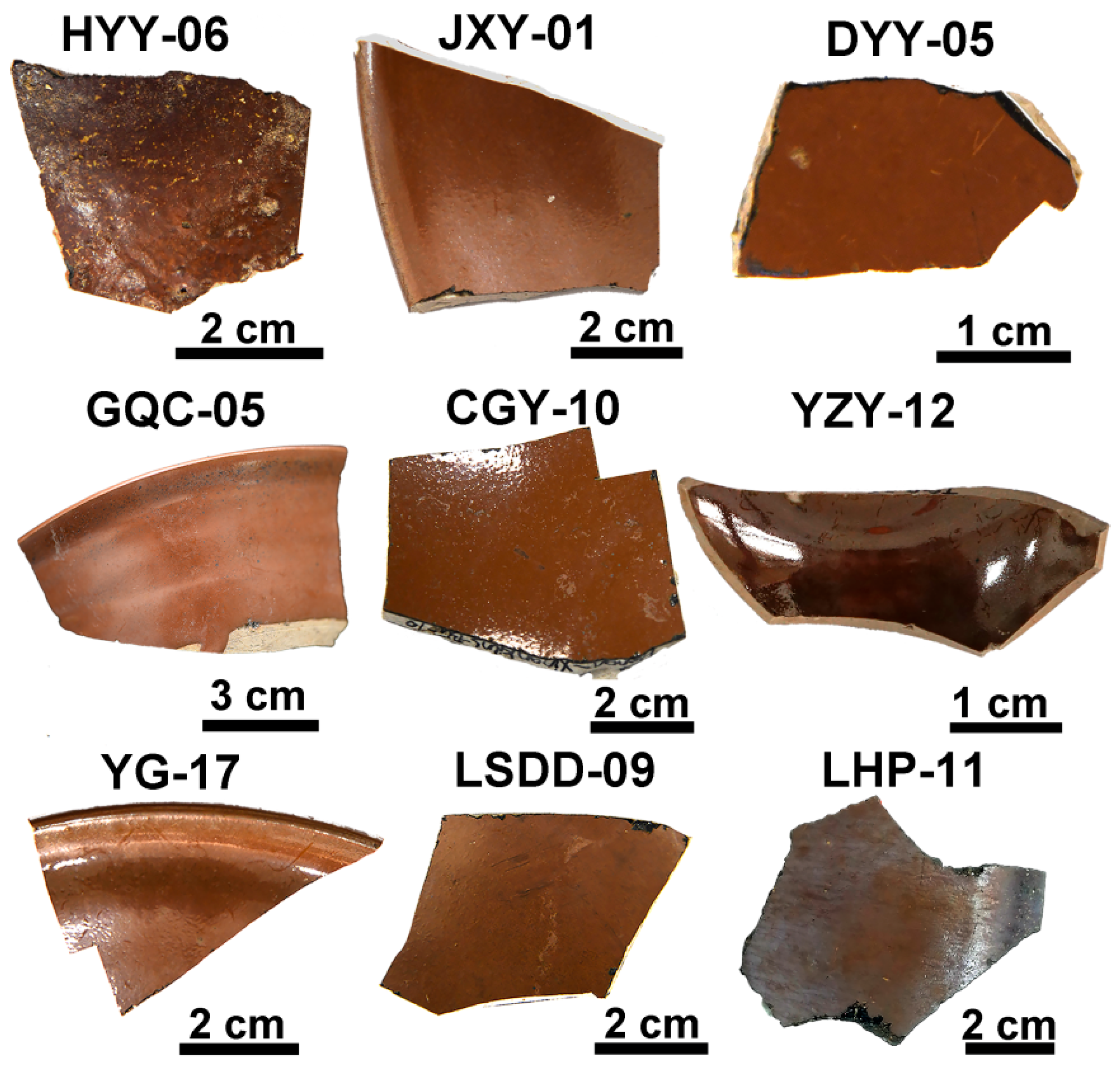


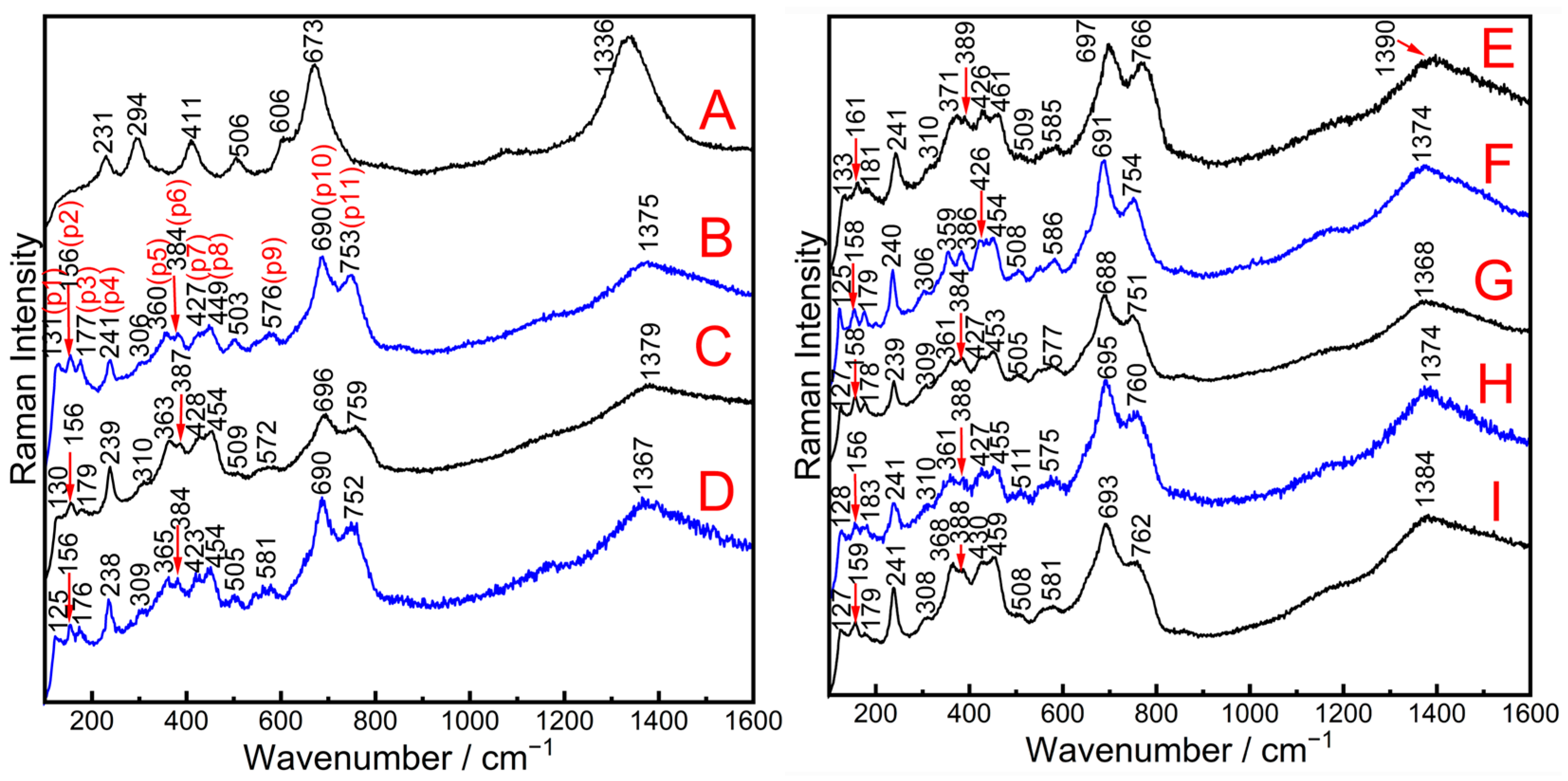

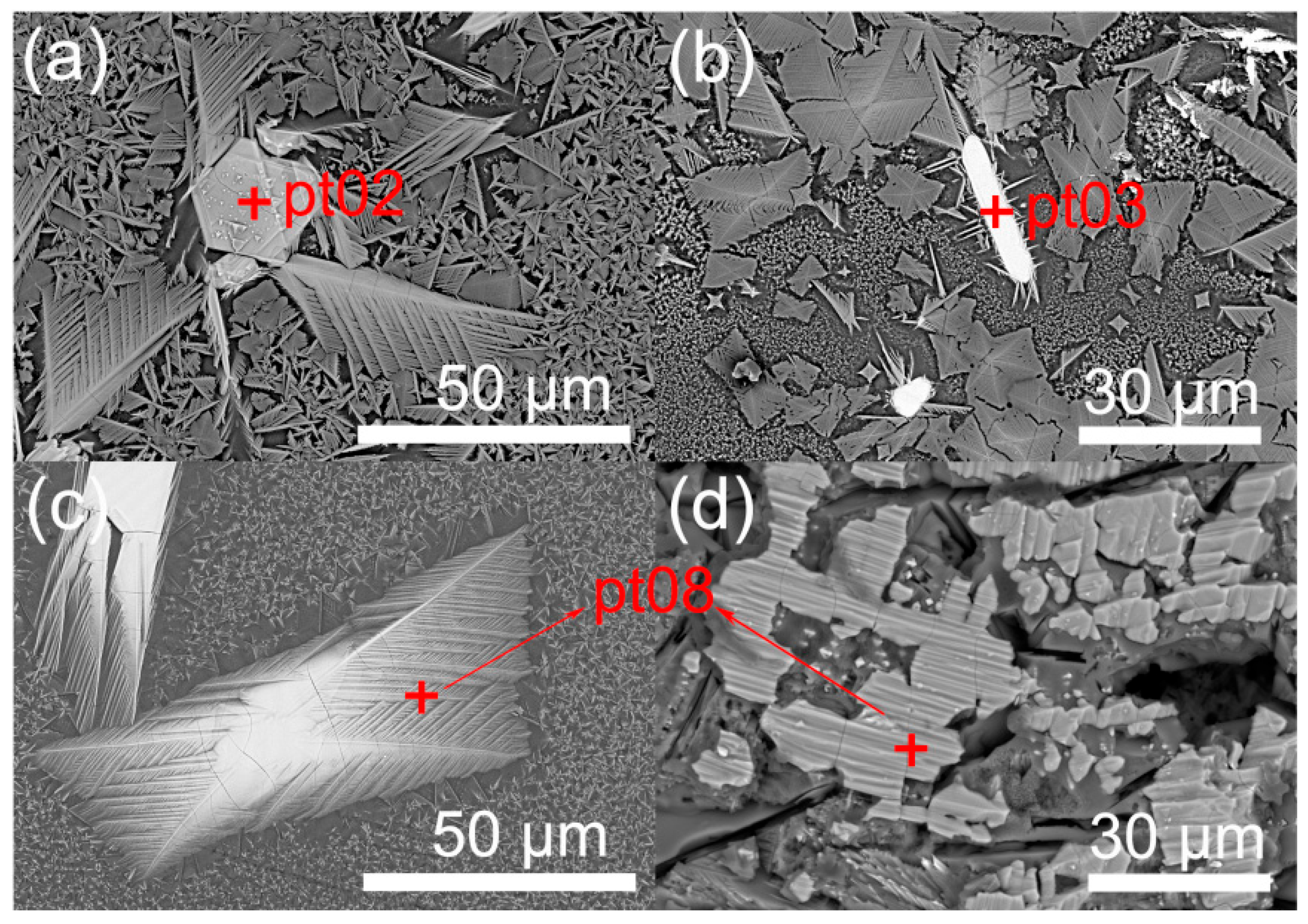
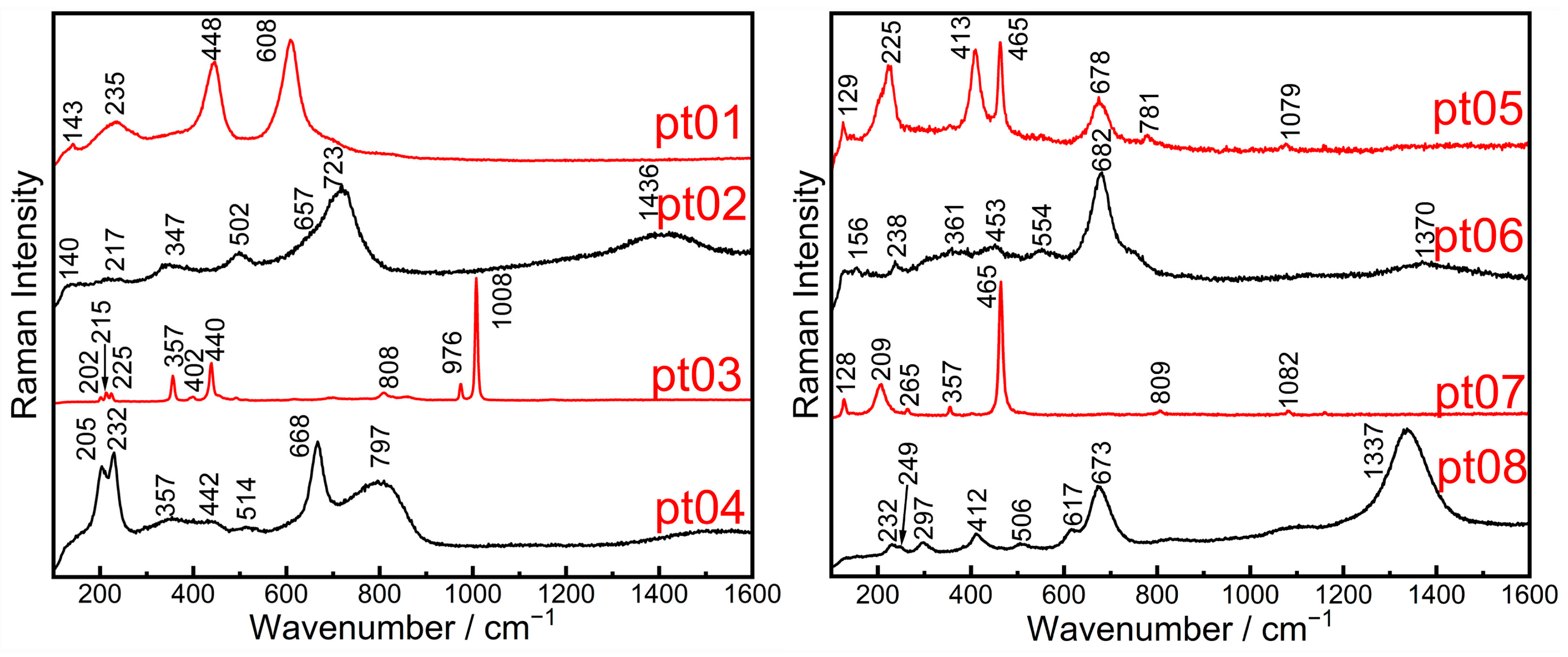
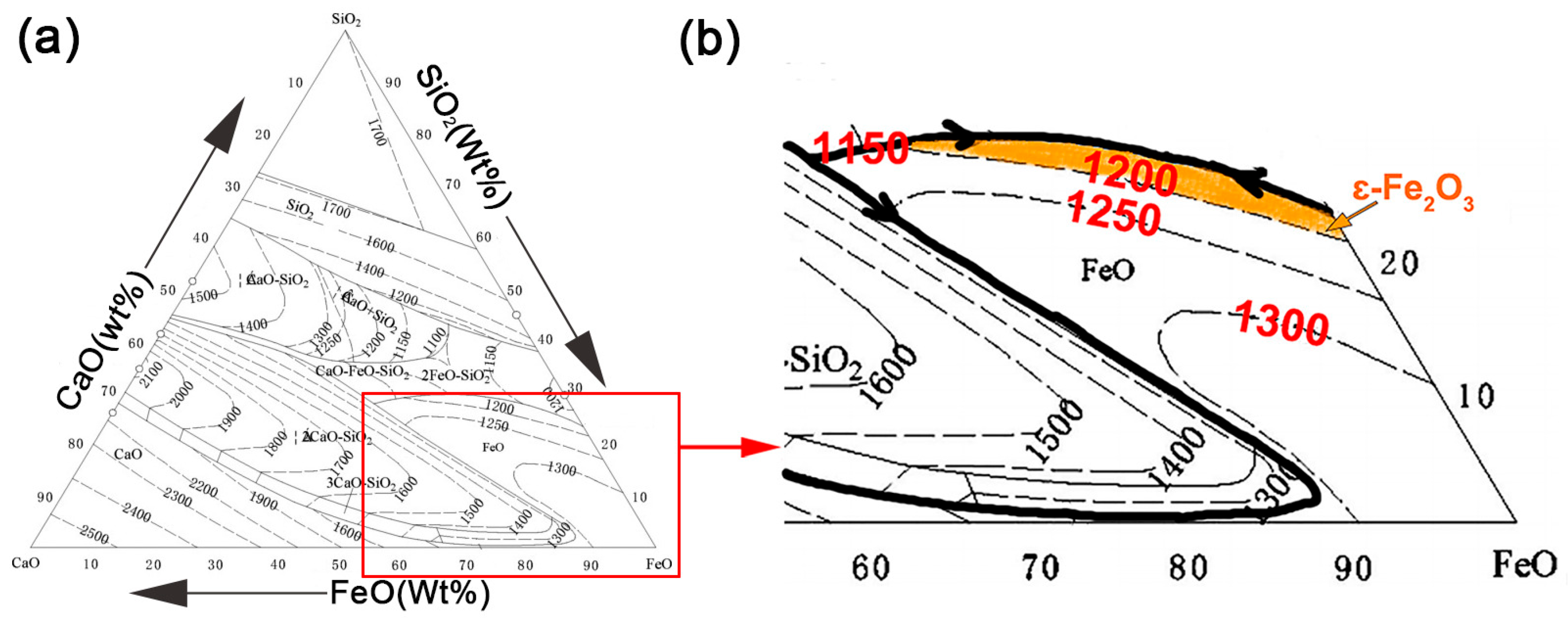
| Samples | ε-Fe2O3 | Hem | Magn | Mafe | Zir | Ana | PS | Rut | Cor | Crs | Qtz | Mul |
|---|---|---|---|---|---|---|---|---|---|---|---|---|
| HYY-01~06 | × | × | × | × | × | × | × | × | ||||
| JXY-01~03 | × | × | × | × | ||||||||
| DYY-01~06 | × | × | × | × | × | × | × | × | ||||
| GQC-01~08 | × | × | × | × [21] | × | × | × | |||||
| CGY-01~11 | × | × | × | × | × | × | × | × | × | |||
| YZY-01,05~12 | × | × | × | × | × | × | × [11] | × | × [11] | |||
| YG-01~10 | × | × | × | × | × | |||||||
| LSDD-01~12 | × | × | × | × | × | × | × | |||||
| LHP-01~05 | × | × | × | × | × [14] |
Disclaimer/Publisher’s Note: The statements, opinions and data contained in all publications are solely those of the individual author(s) and contributor(s) and not of MDPI and/or the editor(s). MDPI and/or the editor(s) disclaim responsibility for any injury to people or property resulting from any ideas, methods, instructions or products referred to in the content. |
© 2025 by the authors. Licensee MDPI, Basel, Switzerland. This article is an open access article distributed under the terms and conditions of the Creative Commons Attribution (CC BY) license (https://creativecommons.org/licenses/by/4.0/).
Share and Cite
Wang, T.; He, Z.; Xia, S.; Sciau, P.; Shao, A.; Ren, Z.; Wang, F.; Zhu, J.; Wang, Y.; Li, Q.; et al. Micro-Raman Study of Chinese Iron-Based Brown Wares Produced During Song Dynasty (960–1279 CE): Probing Crystals in the Glazes. Heritage 2025, 8, 480. https://doi.org/10.3390/heritage8110480
Wang T, He Z, Xia S, Sciau P, Shao A, Ren Z, Wang F, Zhu J, Wang Y, Li Q, et al. Micro-Raman Study of Chinese Iron-Based Brown Wares Produced During Song Dynasty (960–1279 CE): Probing Crystals in the Glazes. Heritage. 2025; 8(11):480. https://doi.org/10.3390/heritage8110480
Chicago/Turabian StyleWang, Tian, Zilong He, Senwei Xia, Philippe Sciau, Anding Shao, Zhao Ren, Fen Wang, Jianfeng Zhu, Ying Wang, Qiang Li, and et al. 2025. "Micro-Raman Study of Chinese Iron-Based Brown Wares Produced During Song Dynasty (960–1279 CE): Probing Crystals in the Glazes" Heritage 8, no. 11: 480. https://doi.org/10.3390/heritage8110480
APA StyleWang, T., He, Z., Xia, S., Sciau, P., Shao, A., Ren, Z., Wang, F., Zhu, J., Wang, Y., Li, Q., & Luo, H. (2025). Micro-Raman Study of Chinese Iron-Based Brown Wares Produced During Song Dynasty (960–1279 CE): Probing Crystals in the Glazes. Heritage, 8(11), 480. https://doi.org/10.3390/heritage8110480






